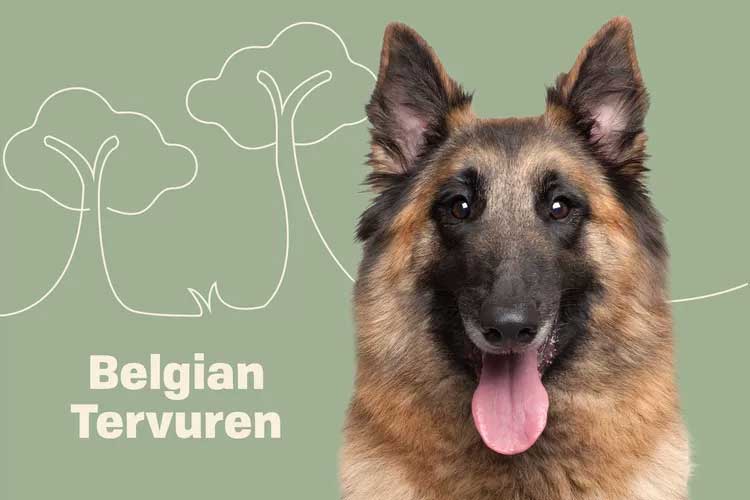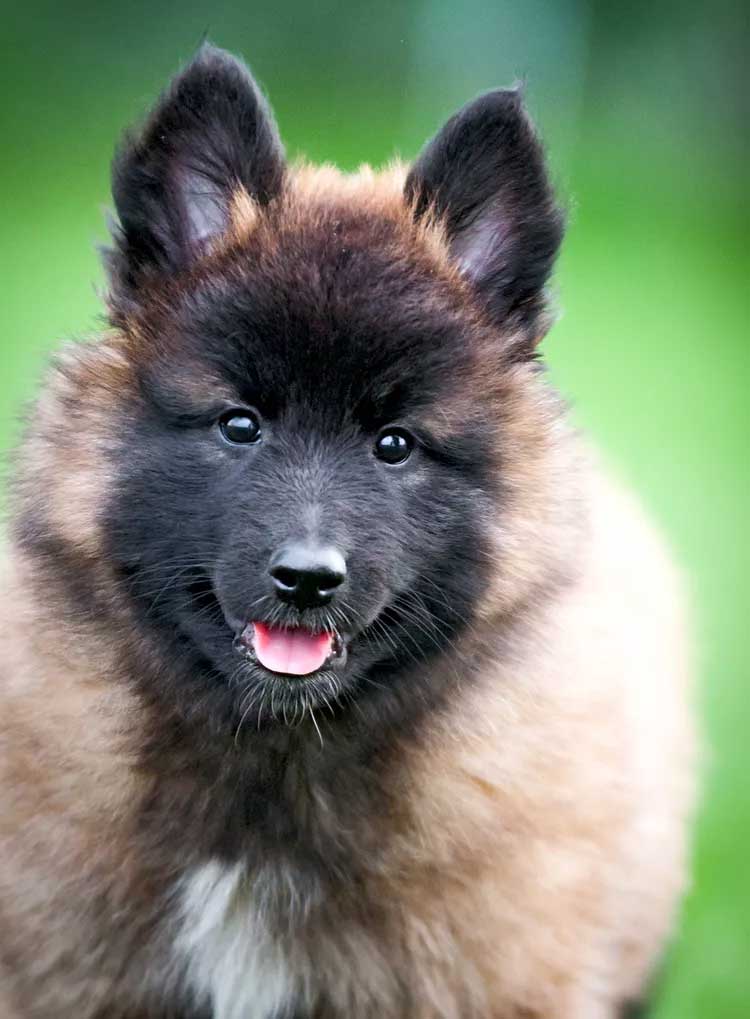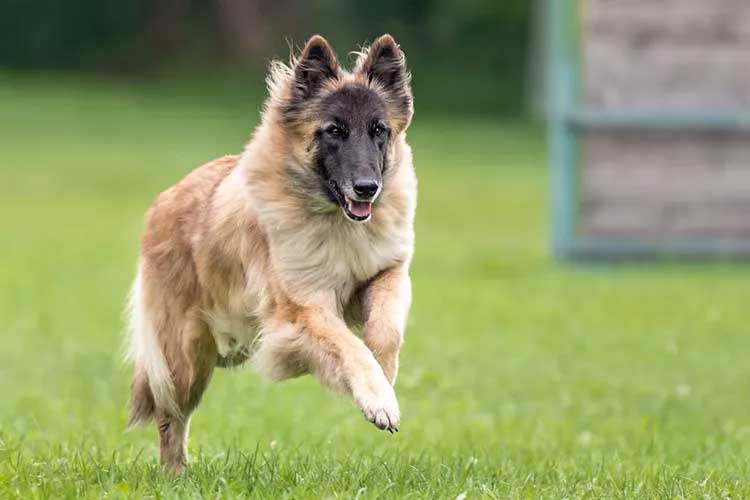Athletic, intelligent, and endlessly loyal, the striking and surprisingly goofy Belgian Tervuren thrives when he has a job to do, space to explore, and an experienced owner to guide him.

Belgian Tervuren Overview
| OFFICIAL NAME | Belgian Tervuren |
| COMMON NAME | Belgian Tervuren |
| PET HEIGHT | 22 to 26 inches |
| PET WEIGHT | 45 to 75 pounds |
| LIFESPAN | 12 to 14 years |
| GOOD WITH | dogs, families |
| TEMPERAMENT | aloof, playful |
| INTELLIGENCE | high |
| SHEDDING AMOUNT | normal |
| EXERCISE NEEDS | high |
| ENERGY LEVEL | active |
| VOCAL LEVEL | frequent |
| DROOL AMOUNT | low |
| BREED GROUP | herding |
| BREED SIZE | medium (26-60 lbs.) |
| COAT LENGTH | medium |
| COLORS | black, brown / chocolate / liver, fawn, red |
| PATTERNS | bicolor, brindle |
| OTHER TRAITS | cold weather tolerant, easy to train, good hiking companion, high prey drive, loves water, strong loyalty tendencies, tendency to chew |
The Belgian Tervuren is a true attention-getter with his striking double coat and intense, curious expression. And that works out well because he demands a lot of attention from his owners!
In fact, the breed standard describes him as "usually in motion when not under command," which tells you a lot about his work ethic and trainability. This loyal herding breed is both highly intelligent and high energy, which makes him best suited for experienced dog owners and families who know how to stay one step ahead of him—or at least keep up with him most of the time.
Although he's a natural fit for police and military K9 duties, he's not all work and no play! His fans love him as much for his sense of humor as for his ability to get the job done.
Appearance
The Belgian Tervuren, or Terv, stands proud, and it's no wonder why. This medium-sized, muscular herding dog is alert and athletic with a prominent, rich fawn-to-russet-mahogany double coat with black overlay that typically darkens with age. He has a strong, flat back; a black muzzle; stiff, triangular ears; and his dark brown eyes are always on the lookout, seeming to ask, "What now? What's next?"It's generally easy to tell male Tervs from females, both due to their shaggy manes and because males are larger, weighing 55–75 pounds, compared to females ranging from 45–60 pounds.

That coat may be impressive, but it isn't as high maintenance as you might assume.
"Brushing or combing once a week is generally fine," says Deb Eldredge, DVM, who has shared her life with Tervs since 1985. She says that line brushing, where you hold the hair up as you brush in order to get the undercoat, is ideal. And when they do "blow coat" a couple of times a year, giving them a warm bath and drying them with a strong blow dryer takes care of the loose hair.
She doesn't consider Belgian Tervuren shedding much of a big deal at all, saying, "Honestly, my Pembroke Welsh Corgi sheds more." Outside of that, these dogs don't need many baths thanks to their dirt-shedding coat.
Temperament
Intelligent, intense, and utterly devoted to his people (but wary of outsiders), the Belgian Tervuren temperament belies his origins as a working dog. And between his bright mind and high energy, he's not an ideal pick for novice dog owners.But that doesn't mean this can't be an amazing addition to the right family, so long as that family is willing to put in the work with their Belgian Tervuren puppies.
"It is important to socialize them well and to commit to training," Eldredge says. "A well-trained Terv is a joy to live with."
Erin Askeland, CPDT-KA, CBCC-KA, animal health and behavior consultant at Camp Bow Wow, agrees.
"This is not a dog for someone who thinks a long walk or casual run will be enough exercise, or for someone who's out of town a lot," she says. "Tervs need someone who considers their dog their companion and is going to dedicate their time to finding the right activities for them."
Although he's a member of the herding group, the Terv also originally worked as a farm guardian—and he can be suspicious around strangers if he's not properly socialized, Eldredge says.
"Most Tervs have a good sense of appropriate reactions, but that comes from socialization and training," she says. "Don't expect your Terv to love everyone or even want to interact with everyone. Many of them are simply happiest with their families, though they need to tolerate other people and behave as you direct them."

And while he might not warm up super quickly to newbies, when it comes to his family, he's intensely affectionate—although he may be less likely to show his love with snuggles and more likely to follow you from room to room, making eye contact as he watches to see how he can "help."
As serious as a Belgian Tervuren may be about his work, this breed is a goofball at heart.
"They totally fit the popular memes where a huge dog carefully, foot by foot, climbs up into your lap—apparently feeling you won't notice," Eldredge says. "If they 'steal' something they should not have, like a napkin off the table, they either do victory laps flaunting their prize, or quietly walk by you, with head down, assuming that 'you can't see them.'"
Living Needs
The Belgian Tervuren needs plenty of mental and physical stimulation. Eldredge, for example, lives on a 65-acre farm, walks her dogs a mile each morning, trains them in various sports during the day, and brings them along to do barn chores. They swim in the summer, too."That said, they do have an 'off switch' and will just hang with me as well," she says. She emphasizes the importance of mixing daily physical exercise, like running or hiking, with mental work like tracking.
Askeland also says Tervs can excel at Treibball, a relatively new dog sport where dogs drive oversized, inflatable balls into a goal, engaging their herding instinct without arousing their prey drive.
But just because they're capable of learning—and excelling at—just about every dog sport imaginable, from agility to disc sports to all kinds of scent work, Eldredge cautions that it's important to find an instructor who understands that the breed is sensitive and doesn't do well with drilling.
"My dogs do something maybe two or three times at most in class, then I break it off to play with them," she says. And because these dogs will go, go, go until they drop, it's up to a responsible pet parent to keep them from doing too much.

Homes with large, securely fenced yards are great for the Belgian Tervuren, although if you're dedicated to getting him out on lots of different trails for runs and hikes, that can work, too. Just keep in mind that he'll quickly become bored with a repetitive route, Askeland says.
He can be a great dog with older children, but small children can be tricky due to his strong herding instinct—he might try to round them up! When it comes to cats, he may be feline-friendly, particularly if he's raised with them, but if the kitty takes off running, that's likely to arouse his chasing instinct. Other dogs are a better bet, particularly if he's introduced to them from day one and learns to be accepting early on.
Mental stimulation through continued, varied, positive reinforcement training is always a good idea, and puzzle toys are also fun for Belgian Tervurens—although not just any puzzle will do.
"You need different types of advanced puzzles," Askeland says. "If you do the same puzzle three times a week, they'll solve it in 10 seconds." And after that, they may go off and find their own form of entertainment, which may be a little more destructive than you'd like.
Care
Grooming a Belgian Tervuren's luxurious fur isn't as intense as you might expect it to be. His harsh double coat naturally repels dirt, so unless he rolls in something stinky—which is absolutely a possibility—he won't need many baths.A weekly thorough line brushing (in which you hold the hair up while you brush to get the undercoat) should be enough most of the time. Use those weekly brushings as an opportunity to bond and keep an eye on his ear health (cleaning as needed), dental health, and nails (which should be trimmed if you hear them tapping on the floor).
Tervs are extremely responsive to reward-based training, although they're such tremendous problem solvers that it can be a challenge to keep ahead of them. Training him with positive reinforcement techniques and giving him consistent cues he can understand will win this dog's trust and respect. And when you have that, he'll do anything you ask.
And when it comes to tricks, Eldredge says to be prepared for him to take what you've taught him to the next level: "You teach your dog to shake, and he moves on to 'high five' on his own."
Health
While they're a pretty healthy breed overall, there are a few conditions you want to make sure your Belgian Tervuren breeder has screened for. The American Belgian Tervuren Club recommends a hip evaluation, elbow evaluation, thyroid evaluation, and ophthalmologist evaluation."Progressive retinal atrophy, cataracts, and pannus would all be checked for with that yearly ophthalmic exam," Maggie Brown-Bury, DVM, past president of the Newfoundland and Labrador Veterinary Medical Association, says. "They are also noted to have persistent pupillary membranes, retinal dysplasia, and optic nerve hypoplasia/micropapilla. So you definitely want to have their eyes well checked regularly!"
Epilepsy is also a concern in the breed, Brown-Bury says: "It can be heritable, meaning passed on from one generation to the next, so this is something to ask your breeder about for sure if you are getting a Terv puppy."
Eldredge also recommends asking Belgian Tervuren breeders about gastric cancer—or any cancer, really. "There are not currently tests for those problems," she says," but a good breeder can tell you relative risks from their breedings."
And while it's not inherited, injury can be a concern, too.
"With any large and active dog, I worry about joint injuries," Brown-Bury says. "And this is best prevented by maintaining a lean weight and a regular exercise regime."
History
Originating in the late 19th century, the Terv started out as a Belgian sheepdog with a distinctive long coat, according to the breed club. It wasn't until dog shows became more popular that breeders began working to create a more uniform appearance rather than simply breeding for intelligence and trainability. Regardless of their name, though, the Belgian Tervuren's mental acuity and athleticism made him invaluable to farmers, who kept the dogs as herders and guard dogs.As mechanized farming became more common, farmers had less need of canine farmhands, but the breed's work ethic quickly earned the Terv jobs as military and police K9s, search-and-rescue workers, and service dogs, in addition to their prowess at dog sports and in dog shows. The Terv officially made his way to the U.S. for breeding purposes in 1953. The breed was recognized as the Tervuren (rather than the Belgian sheepdog) by the American Kennel Club in 1959 and in 1960, the first national breed club formed.
Fun Facts
Curious about the Belgian Tervuren vs. Belgian Malinois? There's a good reason they look so similar. Outside of the AKC, the Terv is one of four Belgian shepherds (along with the Belgian Malinois, Belgian Groenendael, and Belgian Laekenois) that are not considered separate breeds, but rather members of the same breed with different coat types.While they might seem quite similar at first glance, there are numerous differences in the Belgian Tervuren vs. German shepherd, including size (German shepherds are larger), colors (German shepherds come in a wide variety), and the mane or collarette (only the Terv has one).
Ever seen the movie The Company of Wolves? The wolves were played by Belgian Tervuren!
The breed's name comes from the Belgian village of Tervuren, which was the home of one of the dogs' earliest devotees. But the Terv is called the chien de Berger Belge back home in Belgium—even in Tervuren.